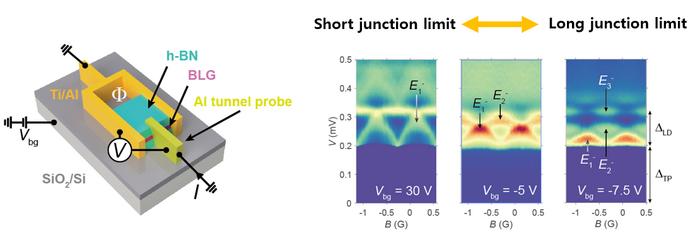Professors Gil-Ho Lee and Gil Young Cho from the Department of Physics at Pohang University of Science and Technology (POSTECH) in South Korea in collaboration with Dr. Kenji Watanabe and Dr. Takashi Taniguchi from National Institute for Materials Science (NIMS) in Japan have successfully controlled the quantum mechanical properties of Andreev bound states in bilayer graphene-based Josephson junctions using gate voltage. Their research has been published in Physical Review Letters, the international journal in the field of physics.

Credit: POSTECH
Professors Gil-Ho Lee and Gil Young Cho from the Department of Physics at Pohang University of Science and Technology (POSTECH) in South Korea in collaboration with Dr. Kenji Watanabe and Dr. Takashi Taniguchi from National Institute for Materials Science (NIMS) in Japan have successfully controlled the quantum mechanical properties of Andreev bound states in bilayer graphene-based Josephson junctions using gate voltage. Their research has been published in Physical Review Letters, the international journal in the field of physics.
Superconductors are materials that exhibit zero electrical resistance under specific conditions such as extremely low temperatures or high pressures. When a very thin normal conductor is placed between two superconductors, a supercurrent flows through the normal conductor due to the proximity effect where superconductivity extends into the normal conductor. This device is known as a Josephson junction. Within the normal conductor, new quantum states called Andreev bound states are formed, which are crucial for mediating the supercurrent flow.
The number of energy levels in the Andreev bound states, which determines the electrical properties of a Josephson junction, depends on the ratio of the “conduction channel length” (the length of the normal conductor) to the “superconducting coherence length” (the length along which the superconducting state can be maintained in the normal conductor). When the conduction channel is short and the number of Andreev bound state levels is limited to a pair, the system is said to be in the “short junction limit.” Conversely, if there are more than two pairs, it is referred to as the “long junction limit.”
In this study, the research team used gate voltage to control the quadratic energy dispersion of bilayer graphene as well as the superconducting coherence length in real time. Utilizing tunneling spectroscopy developed in their previous work, they observed the change of the Andreev bound states at different gate voltages in real time and confirmed that the experimental results matched theoretical predictions.
Geon-Hyoung Park, lead author and researcher at POSTECH’s Quantum Information Device Research and Education Center, stated, “We have observed the Andreev bound states in the long Josephson junction limit, a phenomenon predominantly seen in the short Josephson junction limit.” He added, “We anticipate that the number of energy levels can be readily adjusted by applying gate voltage alone, offering potential applications in diverse fields such as quantum computing and high-precision quantum sensors.”
The research was conducted with support from the National Research Foundation of Korea, the Ministry of Science and ICT, the ITRC, Air Force Office of Scientific Research, the Institute for Basic Science (IBS), the Samsung Future Technology Incubation Program, Samsung Electronics, the Basic Science Research Institute, the JSPS KAKENHI, and the World Premier International Research Center Initiative (WPI).
Journal
Physical Review Letters
DOI
10.1103/PhysRevLett.132.226301
Article Title
Controllable Andreev Bound States in Bilayer Graphene Josephson Junctions from Short to Long Junction Limits
Article Publication Date
30-May-2024




